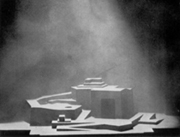

|
| Syllabus
|
| Project 03 | Physical Lighting of an Interior |
assignment
description Designer:Norman Geddes Play: The Mother of Christ Publisher: John Jay Company Book:Theatre Arts Prints (1929) |
This project studies
concepts involving lighting style and the progression of light over time in a non-
changing physical environment. Design approach will be derived from an
understanding and application of a chosen film style. The approach is then applied
to the lighting of a room over the course of one day. The following elements have been added to the still life composition: a backing wall with a window opening, and various choices of non-theatrical (residential and commercial) light fixtures . Each team will select a film type, as distinguished by genre (action/adventure, horror, science fiction, epic, western, musical, romantic comedy, crime/gangster, thriller, war) that is particularly suited to the application of dramatic light in the environment provided. Apply the selected genre to lighting design decisions to express the passage of a single day in the still life enclosure. Select various time-of-day moments for each team participant, mindful that the task is to orchestrate a believable sequence of one day. Use light to establish a clear sense both of interior and exterior. Determine the most effective "start" and "end" to the day, then design and program a linked lighting cue sequence. Sequences should be approximately two minutes in length. |
| notes | in advance of studio work,
map out lighting events through the use of lighting keys, light
sketches, or photographic images
use one or more of the available artificial lighting fixtures to suggest a time progression; support any/all dramatic visual events with lighting effects as demonstrated in class; consider foreground / background and interior / exterior relationships in creating design composition |
| grading criteria | Project evaluation is based on group participation, understanding of and expression of selected film style, integration of theatrical and artificial lighting, use of lighting effects, and overall quality of the presentation. |
| documentation | In addition to taking several still photographs of each time-of-day moment, make two to three digital video recordings of the lighting sequence. Vary positioning of the camera in relation to the composition to provide more options for subsequent video editing for a quicktime movie.The images and quicktime will eventually be posted on your web page. |
| Syllabus
|
| Copyright 2001 Advanced Computing Center for the Arts and Design and the Department of Theatre The Ohio State University |